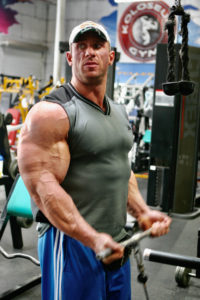
An advanced arm workout for those who want to be as strong as they look
Strength Sensei CP
Do you want bigger arms? If you are a “training meathead,” of course you do! Even the most accomplished IFBB professionals seek strategies for bigger arms.
Here is an advanced routine for arm mass and strength development. Do it once every five days. I’ll start with the workout, then break down the finer points of how to perform each exercise.
A1. One Arm Scott Zottman Curl, 5 x 4-6 on a 41X0 tempo
A2. One Arm Standing Dumbbell Press, 5 x 4-6 on a 40X0 tempo
B1. Incline Off-Set Dumbbell Curl, 4 x 7-9 on a 40X0 tempo
B2. V-Bar Dips, 4 x 7-9 on a 32X0 tempo
One Arm Scott Zottman Curl.It is best to use a seated Scott bench for this exercise, as it minimizes the opportunity for cheating. I prefer to use the Atlantis version.
Ideally, you should have a partner hand you the dumbbell. Using a supinated grip (palms facing the ceiling), curl the dumbbell to the point just before tension on the elbow flexors is lost. At this point, pronate your forearm completely so that your palm is facing away from you.
When you lower the weight, the biceps brachii will have an ineffective line of pull, thereby shifting the load to the under-lying brachialis and the brachioradialis. Make sure your elbow flexors are fully stretched in the bottom position of the eccentric range before you supinate your wrist to begin the next rep. To enforce this technique, your forearms should contact the padded surface of the Scott bench at the end of the eccentric range, as it minimizes the opportunity for cheating.
Remember — go for full range.
One Arm Standing Dumbbell Press.Stand and hold a dumbbell in the non-dominant hand. Brace the other hand by holding on to one power rack post. If you are holding the dumbbell in the left hand, your right leg is forward in a semi-lunge position; your right arm is extended at shoulder level, holding on to the power rack post.
This exercise allows you to lift for a greater range of motion in the pressing range as the scapulae can move more freely than in the two-hand dumbbell press. It will stretch the shoulder muscle in a way to which you may not be accustomed. The key here is to keep the hand in a neutral grip (semi-supinated grip), not a pronated grip (palms-down grip).
By training only one side at a time, you will allow the scapulae to move over a greater distance. Make an extra effort to bring the biceps as close to your head as possible when you are nearly completing the concentric range. Again, “biceps to head,” not “head to biceps.”
Again, the extra range comes in handy to restore shoulder health. Always start the series with your non-dominant arm and match the reps with the dominant arm. Do not do more reps on the dominant arm, as it will accentuate the discrepancy. And do not wear a weightlifting belt!
Make sure you keep the legs out of it. Once your legs are in the starting position, they don’t move any more until the set is over.
Incline Off-Set Dumbbell Curl.For this exercise, sit on an incline bench and hold the dumbbells with an offset grip (i.e., an asymmetrical grip where the thumb side of your hand rests against the inside surface of the dumbbell plate.)
Start the exercise with your wrists semi-supinated (i.e., as if holding a hammer.) Curl the weight to about 40 degrees of elbow flexion. Then, supinate your wrists (i.e., turn your palms up), and complete the curling movement. Your forearms should touch your biceps. The purpose of the offset grip is to increase the involvement of the short head of the Biceps upon wrist supination.
V-Bar Dips.This exercise is the king of triceps builders. Yet, like other ever-demanding movements such as squats and chins, it is rarely found in a Men’s Fitness pulley-artist type of routine.
You can use parallel or V-shaped dipping bars. The V-shaped bar is preferable. If you have access to one, use as narrow a grip as possible without compromising shoulder integrity. Grasp the bars and boost yourself until you are stabilized over them at arm’s length. Lower yourself until your biceps make contact with your forearms. Your triceps must get fully stretched. Once you reach the bottom position, press yourself back up by extending your elbows. Try to stay as upright as possible throughout the range of motion. If you lean too far forward, you will increase pectoralis recruitment.
If you can’t lower yourself under control until your biceps make contact with your forearms, perform the decline close-grip bench press until you have sufficient arm strength. If you have incomplete range of motion on triceps dips, they are a complete waste of time.
Along the same lines, don’t cheat yourself by doing chopped reps (i.e., not going down all the way and coming up only three-quarters of the way). Also, your elbows should go only to 98 percent of full elbow extension to maintain maximal tension on the triceps. Please, don’t resort to the “geek” version, where you put your feet on a bench in front of you and your hands on another bench behind you. This exercise (along with Smith Machine pressing exercises) is one of the major causes of shoulder impingement syndrome among bodybuilders.
At first, your bodyweight will probably suffice as a means of resistance. As you get stronger, you can progressively increase the resistance by holding a dumbbell between your legs.
A better alternative is to hook a plate or dumbbell onto a specialized chin/dip belt. There are many models on the market, but I prefer the ones that are standard leather lifting belts with hooks sewn in.
This routine will pack on mass in no time. Enjoy the increased size!
